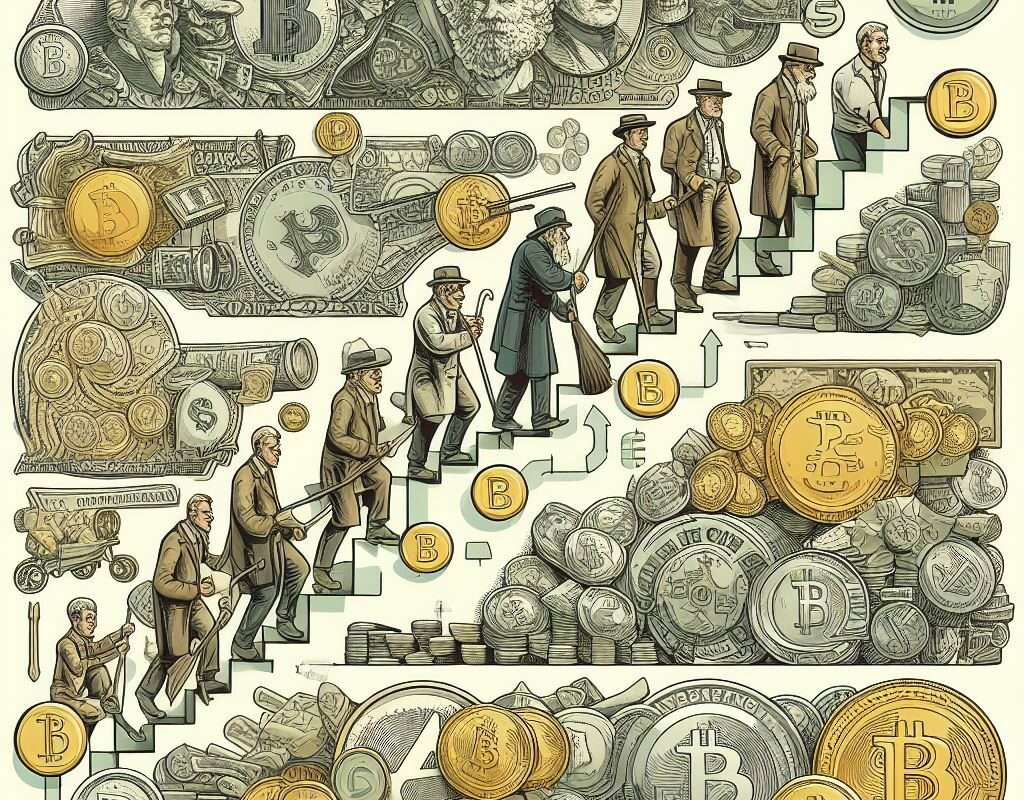The money primarily is a medium of exchange that was needed to replace the inefficient barter system. However, the concepts regarding money are not always simple. If there is an excess money supply in the economy, then that can devalue the currency and also cause inflation. Inflation in extreme and scary cases like Zimbabwe, Venezuela, etc…. or less scary but yet disparaging cases of Pakistan, Nigeria, the Netherlands, the UK, etc.… have led to question the central banking which has monopoly control of money supply.
To avoid the central bank’s inflationary policy and weird experiments using monetary policies different economists found different alternatives. Friedman proposed a strict monetary policy system where the money supply will be consistently maintained with money demand or economic growth. Murray Rothbard asked to go back to the gold standard and remove the central bank. Agreeing that there is no need for central banks with the gold standard, George Selgin and Lawrence H. White used historical evidence and an alloy of different theories to propose free banking but in the existence of fractional reserve banking.
But in all this, there was a unique approach. F.A. Hayek in his 1976 book The Denationalisation of Money proposed a system of private currencies. There would be fiat currencies where different banks with their own brand of currency will privately issue currency with no existence of legal tender. He asked for market competition between currencies. Due to competition no issuer would print more money and devalue their currency over another.
Economists didn’t take this concept of Hayek’s seriously. Very few even bothered to critique it too. But, in 2008 a pseudonymous Satoshi Nakamoto developed a digital private currency called Bitcoin. The primary aim of Nakamoto was to create a private currency that was non-inflationary and stable. What Nakamoto brought up around 2008 was already theorized by Hayek in 1976. Probably cryptocurrency is the best real-world description of his theory.
After doing a work of genius, there was an important thing for Nakamoto to do, which was to make Bitcoin a medium of exchange. Now this case differs from gold. Here bitcoin has no intrinsic value, then how and why would people use it as a medium of exchange? To make it happen there were attempts to make people believe that Bitcoin in future would become a medium of exchange. This way people would start adopting it too. Unlike gold derived from spontaneous order and fiat currencies imposed by coercion of government and legal tender, the bitcoin approach was different. Like fiat currencies, it has no intrinsic value but like gold, it is a free market phenomenon and stateless. In a way, Bitcoin seems like an approach taking bits of both Gold and Fiat standard.
Bitcoin which was nothing once now has huge value in monetary terms. But, this cannot be justified as its success too. The major problem with Bitcoin is that it didn’t go as well as what it was established for. Rather than being a medium of exchange, it is more popularly used as an investment tool. Even though there have been some transactions done with Bitcoin, it still isn’t a widely accepted medium of exchange to make it qualify as “money” yet.
Bitcoin supply is just like the supply of fiat currencies under central banks. It is inelastic to purchasing power (price of currency) or the supply curve is vertical. This, which might seem like a positive aspect of Bitcoin or any other cryptocurrencies, turns out to also become their major problem. If supply is constant, then the change in demand for Bitcoin will increase its purchasing power. This won’t keep the value of the currency stable. This is a reason why Bitcoin has become an investment tool where profit is earned with an increase in the price of the currency. This further leads to the currency’s price volatility, which makes its market value uncertain. If a currency’s value is uncertain, it is difficult to be accepted as a medium of exchange.
Bitcoin supply is unresponsive to the demand of it which puts a burden on its price or purchasing power. This way the reason for its existence which is to be a less inflationary and stable medium of exchange is affected. But, if the supply curve (keeping constant) of bitcoin was flat or horizontal then the value of currency would have remained constant with every shift in demand for currency. This would have prevented investors from entering into the cryptocurrency market and also would have enhanced its use as a medium of exchange.
Lawrence H. White who has been doing great work in free banking and private currency for years in his latest book Better Money: Gold, Fiat, or Bitcoin,
“It remains a future challenge to create a programmed cryptocurrency with a supply that responds to demand so as to stabilize its purchasing power over goods and services, in the fashion of the gold standard but even more rapidly, rather than to stabilize its exchange rate with a fiat currency (ordinary stablecoins) or with demonetized gold (gold stablecoins).”
It doesn’t matter how many new features and better services are added by different cryptocurrency issuers. What’s more important is for it to maintain its purchasing power. This is something central banks don’t do for either lowering the interest rates or by expansionary policies. But, despite that the fiat currency by central banks has been more stable than Bitcoin and other cryptocurrencies, making it difficult to challenge the position of central bank.
Gold, on the other hand, has a better history of stability than both fiat and bitcoin. There have been cases of free banking with the gold standard that prevailed for many years but were taken down for bringing money under the control of the government that could easily fund expenditure or control the economy with monetary policy. However, the gold standard presents two challenges. The first is its higher resource costs and scarcity compared to other standards, which becomes more problematic in the case of 100% reserve banking as opposed to fractional banking. Though the gold standard is not perfect and was never claimed to be too and the rejection of it in economics could be considered highly unfair and unjustified.
Considering the discussed instability of Bitcoin as a medium of exchange, it appears that fiat currency remains the best option, offering stability in both the short and long run. Fiat can be responsive to money demand maintaining a certain range of purchasing power of currency, also it faces no such possibility of supply shocks in the long run. But, despite that fiat history has been much worse than gold. This is because of how monetary policies have been, either inflationary or inconsistent. The blame should rather go to the central banks not the system of fiat currency. Fiat currency if following Friedman’s k-percent rule could potentially become the best option for money. But, that has been never tried before by any central bank properly.
In order to prove fiat to be better than gold, the intentions of central banks need to be better and their execution of the plan to match money supply with national income must be successful consistently too. The fiat might become that stable option that doesn’t require gold! Friedman’s k-percent can be implemented by setting constitutional rules and restrictions on the central bank that won’t allow them to distort the money supply. If properly implemented, without a gold standard there can be the establishment of free banking too which has been found in theories of prominent economists like George Selgin and Lawrence H. White. Then the responsibility of banks would be on the bankers and not on central banks and banks would be freer to exercise and adopt efficient means with little to no restrictions and coercion of central banks.
But, after all this, it doesn’t mean that cryptocurrency should be completely disregarded or legally restricted. There is a need for a competition given to fiat standard that would help Bankers to make decisions carefully. The development of cryptocurrency is in process and it must not be affected. It is important to let the market decide what’s the better money. With increasing innovation, there might be ways found that can make money more efficient tool.



